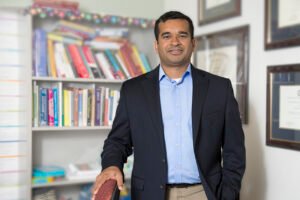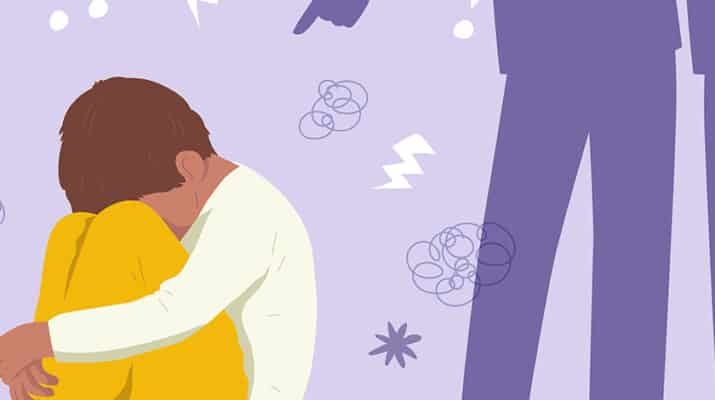By Deborah Jeanne Sergeant
In 2020, 618,000 children in unique incidents were victims of abuse and neglect, according to The National Children’s Alliance. Of these cases, 65% included sexual abuse, 20% physical abuse, 8% neglect, 8% witness to violence, 3% drug endangerment and 8% were other types of abuse or neglect.
Emotional abuse overlaps each of these categories, can occur in the absence of other kinds of abuse, and often goes unreported. These factors make it difficult to estimate how many children experience emotional abuse. But researchers estimate that about 40% of children at some point suffer from it.
Emotionally abusive parents differ from those who exhibit an occasional moment of poor reaction and apologize afterwards.

Jacobs School of Medicine & Biomedical Sciences; 2017
Sourav Sengupta, associate professor of psychiatry and pediatrics at UB Jacobs School of Medicine and hospital psychiatrist at Oishei Children’s Hospital, said that emotional abuse is “a pattern of behavior that gets in the way of a child’s self-worth and normal, healthy development you’d expect. It’s constant criticism, manipulative withholding of emotional support, and not providing that core of basic care and withholding that TLC every child needs. We’re talking about chronic patterns of behavior that invalidate the child, make them feel small, like they can’t go out into the world.”
Emotional abuse occurs in the context of a trusted relationship. Parents who habitually engaged in abusive behaviors teach their children that relationships are dangerous and result in confusion and emotional pain.
Children sometimes cope by adopting inappropriate responses to emotional relationships, like lashing out at those who seek to become close. Or, adopting an inappropriate response such as an older elementary child sitting on a stranger’s lap.
The long-term impacts can include health problems, difficulty in reaching age-appropriate developmental milestones, relationship problems and socioeconomic challenges, to name a few.
“Of children who engage in bullying, a significant portion were bullied themselves,” Sengupta said. “At a young age, we learn to navigate the environment the way the environment treats us.”
Other adult family members, teachers, coaches and other trusted adults may inflict emotional abuse. However, the closer the person is to the children, the more damage the abuse inflicts. In the case of an adult outside the family, the children’s resiliency factors can make a difference as to how much damage the emotional abuse causes.
For example, parents who stick up for their children and support them in a conflict with caustic teacher can help their children learn how to deal with treacherous people and reinforce their own caring relationships.
Helping children find ways to express their thoughts and feelings without judgment is one way that parents can help children feel supported when an emotional trauma occurs.
“The first thing would be to for the parent to really check in with their own emotions and be able to neutralize the response,” said Lori Chiarmonte, clinical supervisor at Child & Family Services in Buffalo. “It gives the child space to express how they’re feeling. Really listening to the child and respond with a calm approach. Let them know they have the space to express how they’re feeling, whether frightened, angry or upset and the parent is almost holding that emotion for the child.”
Not providing this kind of emotional support and environment when emotional abuse happens can contribute to long-lasting effects, beginning with stunting the child’s development, and including their ability to learn at school if that is the context of the emotional abuse.
“If a child experiences these traumas and doesn’t have a safe space what they’ll do is internalize it and develop negative beliefs like, ‘I’m not safe or loveable,’” Chiarmonte said. “That carries on to adult life and negative coping can take place.”
These could include anger, aggression, self-harm and substance use.
For some families, emotional abuse becomes a multi-generational issue as the following generations mimic the behavior they saw in their parents as children. From childhood, their brains have been hardwired to automatically resort to fight or flight mode in the face of conflict instead of extending compassion and understanding. Their understanding of relationships has been skewed into one of competition instead of cooperation.
Breaking the cycle of childhood emotional abuse relies upon the adults addressing their own issues first before changing how they relate and behave with their children.
“Being able to recognize and become aware of the deficiencies is important,” said Samantha G. Stringer, licensed mental health counselor in private practice in Rochester. “At some point in life, we do see our deficits, whether it’s by someone sharing what they see in us or by the emotional hole that’s evident. I believe that everyone has it in us to get to that point where we realize something’s going on. Something doesn’t seem right; I need some help.”
She has treated clients who as young adults do not understand why they act the way they do, but once they begin talking about their childhood, a pattern of abuse emerges: yelling, cursing, emotional or physical abuse.
At that point, they begin to better understand that this behavior is unwarranted and they can work toward changing themselves because they do not want to follow that pattern.
Stringer recommends psychotherapy and talk therapy for unpacking and healing childhood trauma, whether as a child or adult.
“They can do better, think better, live better, have better physical and mental health,” Stringer said. “There is a slew of things we can do. I think about the spiritual aspect of it as well, knowing that spiritual side of yourself and looking at life for what it is.”
She also emphasizes developing purpose and engaging in regular self-care.
“We’re often compassionate with our feelings to friends and family and having that same self-compassion can go a long way,” Stringer added.

